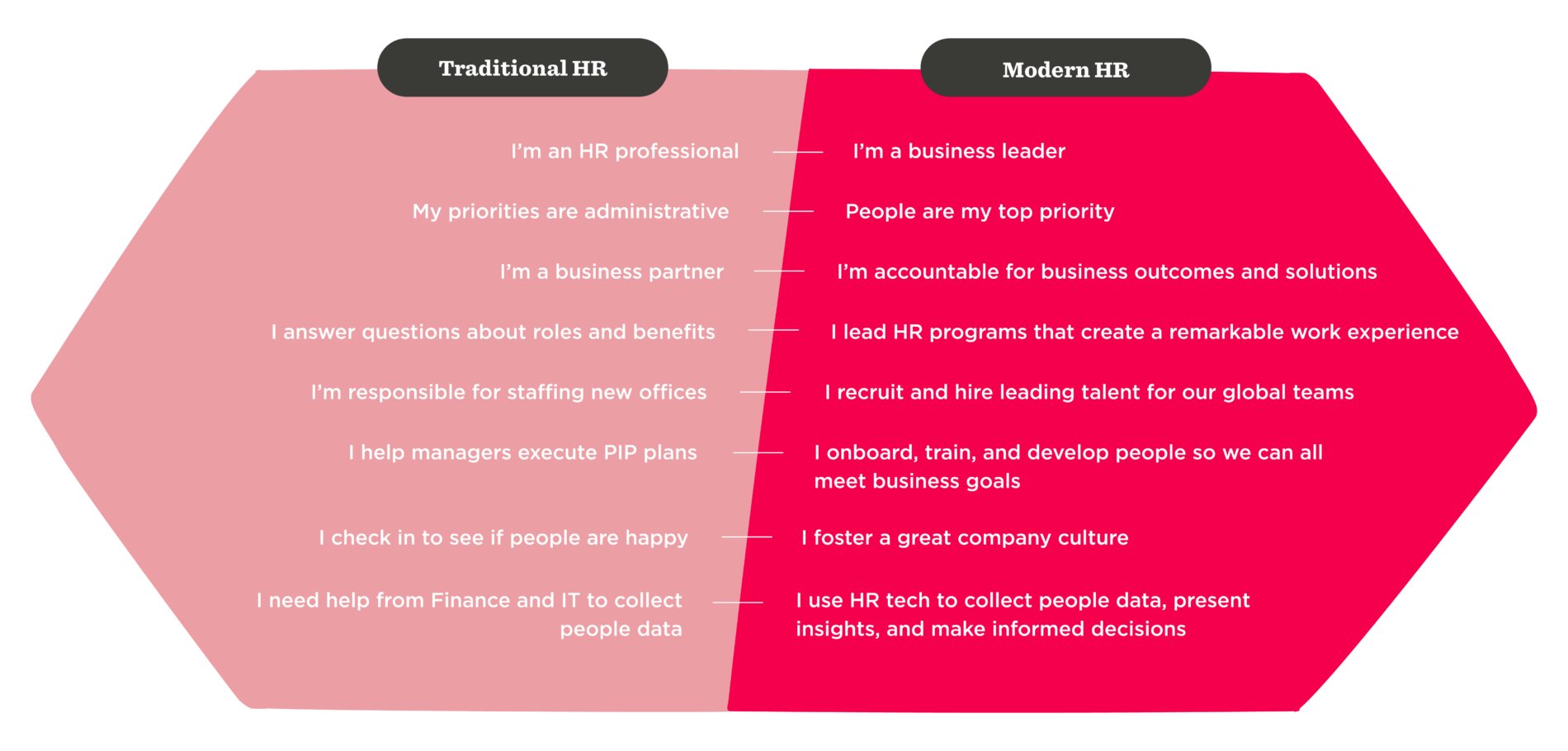In 1998, HBR described the role of Human Resources (HR) as follows:
“In most companies today, HR is sanctioned mainly to play policy police and regulatory watchdog. It handles the paperwork involved in hiring and firing, manages the bureaucratic aspects of benefits, and administers compensation decisions made by others … But the fact remains: the activities of HR appear to be—and often are—disconnected from the real work of the organization. The new agenda, however, would mean that every one of HR’s activities would in some concrete way help the company better serve its customers or otherwise increase shareholder value.”
Today, HR has evolved to be more than just order takers disconnected from the business. Over the last half decade, HR began to actively partner with the business to enhance several different areas. Today, it holds a critical role in the modern workplace—and that role is still evolving.
<< Download the guide to learn more about HR’s vital role in modern businesses >>
“As HR practitioners, we are conditioned to fall into place,” writes Steve Browne in HR Rising!! “We have defined roles, and the expectation is for us to stay within the lines written in some form of a job description. Since we feel this is the only area from which we can perform, we in turn force this narrow approach on others, as well. Everyone in their place. No exceptions. We tend to get highly agitated when people decide to work outside of these defined parameters.”

As COVID-19 spread around the globe in 2020, HR found itself at the center of the crisis in workplaces. Without any defined roles, HR managed health and safety protocols, implemented work-from-home arrangements, addressed vaccine mandates, and conducted site closures, to name a few.
This global crisis and the ensuing collective reliance on HR to keep the businesses operational served as the catalyst that proved HR doesn’t just “partner with the business” but is a vital part of it.
For any company aiming for success, it’s crucial for HR to be deeply embedded in business operations. McKinsey recently conducted research to explore how businesses can best structure themselves for the future—and the findings indicate that companies set for future success share four common characteristics:
- They set a direction to calibrate their ambition
- They focus on cultivating talent
- They invest in forward-thinking leadership
- They “integrate the previous strategic points”
To truly become a vital, thriving part of the business, the most successful HR departments adopt the strategic mindset and approach of “future-ready” companies. This guide will explore how adding these four tactics to your people strategy can help secure HR’s place as a critical part of the business.
The evolution of the modern HR leader

1. They set a direction to calibrate their ambition
In an age that is full of unprecedented change and digital innovation, organizations can find great value in taking a step back and calibrating their true north. Let’s dive deeper into how HR teams can lay out a path that resonates with everyone involved:
Redefine your mission, vision, and values
After the pandemic, people used the phrase “the new normal” to describe the shifting paradigms in the world, including the workplace. But while it’s important to evolve and adapt with the times, it’s always a good idea to reflect on what your organization truly values at its core.
After all, it’s more than just words on paper. It’s about fostering a culture that values diversity, inclusivity, sustainability, and wellbeing. HR plays a pivotal role in shaping an environment where innovation and unity thrive—and your mission, vision, and values play a key role in this.

Rethink your organizational structure
As an HR professional, you hold the keys to fostering dialogue between company leadership and the wider organization to rethink the traditional hierarchical structures.
Flatter organizational structures are slowly becoming the go-to way to work as they align better with the aspirations and working styles of the modern workforce, especially with younger Gen Z professionals. These structures typically promote a culture of open dialogue, collaboration, and mutual respect—leading to improved satisfaction and productivity.
Identify emerging business needs
It’s impossible to overstate the importance of identifying and adapting to the ever-evolving, ever-shifting business landscape. The needs of yesterday might not be relevant in today’s working world, just as the needs of today may not be relevant tomorrow.
Embracing emerging business needs, such as developing AI-based skills and adopting sustainable practices, is essential to remaining competitive and future-proofing your organization. For example, according to the McKinsey study, organizations used an average of 3.8 AI capabilities in 2022, double the 1.9 used in 2018.
This goes to show that realigning the organizational focus toward such innovative practices isn’t just a necessity but an investment in the future.
Define roles and responsibilities
To achieve organizational synergy, defining clear and coherent roles and responsibilities is crucial. But the secret ingredient to success is to align each position with your newly defined organizational objectives, structure, and needs.
This cohesion across your organization enables you to foster an environment of mutual growth and development that aligns with your organizational setup and ambition.
<< Download the guide to learn more about HR’s vital role in modern businesses >>
2. They focus on cultivating talent
Cultivating talent is the cornerstone of organizational success in an era of rapid innovation. But this process goes far beyond just upskilling and reskilling—it’s about fostering a culture of continuous learning and ensuring that your talent development strategies seamlessly align with your revamped business goals and values.
It requires everyone in the organization (not just HR) to think about talent—all the time. But that responsibility for keeping talent front and center lands directly at HR’s doorstep. Here are a few ways HR can focus on talent management.
Commit to learning and development
A commitment to L&D is paramount. Prioritizing upskilling and reskilling initiatives and integrating mentorship programs to facilitate knowledge transfer and skill acquisition can make sure your team is set up for success.
By fostering an environment that values learning, you empower your team to evolve with the organization and adapt to the ever-changing business landscape.
Promote continuous learning
Cultivating talent is an intricate process that involves a holistic approach to continuous learning. Any HR leader intent on securing their organization’s future understands the vital role of providing structure, support, and encouragement to their team.
When your team is equipped with a diverse set of skills and knowledge, they can drive the organization to new heights. That’s why a robust talent development program, rooted in company objectives, yields strong outcomes and is instrumental to aligning individual aspirations with organizational goals.

Align development with organizational goals
Speaking of organizational goals, ensuring your talent development strategy is running in harmony with your newly defined objectives and values is crucial.
When your development program resonates with your goals, it creates a symphony of progress and innovation within your organization. This alignment fosters a cohesive environment where individual learning paths are synchronized with organizational development tracks, putting both your team and your organization on the path to success.
3. They invest in forward-thinking leadership
The modern professional landscape is filled with the phenomena of burnout and “quiet quitting.” Many organizations are actively exploring a variety of avenues such as the return to office (RTO), work from home (WFH), and hybrid working models to try and counter these challenges.
While these methods have seen some success, with four in five people who have worked in hybrid models wanting to retain them, it’s still important to recognize that a more profound transformation in leadership thinking is essential to combat these issues effectively.
Move past hustle culture
Hustle culture is not a remedy to burnout, but a driving force behind it. To promote a healthier workplace experience, it’s best to avoid long, stressful workdays. Instead, foster enthusiasm, engagement, and innovation to realize higher quality work and improve productivity.
To move past hustle culture, businesses can explore a shift from the traditional authoritative leadership model to a more empathetic and supportive one. This is crucial to creating a working environment where people feel valued, respected, and motivated to give their best—day in and day out.
Empower with autonomy
The array of benefits that come from empowering team members with autonomy and freedom is invaluable. Utilizing empathy, flexibility, and people-centric strategies to create a work environment that balances work and personal life and promotes employee wellbeing is a nearly guaranteed way to reduce burnout.
Take tech giant Apple, for example. They have put strategies and policies in place that allow their team members more and more freedom to do their work as they see fit. With an attitude that says, “As long as you get the work done, we don’t care how you do it,” they put their trust in their people to deliver without micromanagement or strict parameters—and it’s clearly paying dividends.
Train strategic management
Empowering management with the right strategies and tools to prevent employee burnout is paramount. Training and development programs that focus on cultivating empathetic, resilient, and forward-thinking leaders can significantly impact the overall workplace environment.
But only 25 percent of people say their organizations’ leaders are engaged, passionate, and inspire their team to the best possible extent, highlighting an area where many businesses can improve.
By championing strategies such as regular check-ins, full flexibility, and open communication channels, management teams can help create a positive workplace culture.

4. They take a people-driven approach
Creating a cohesive and holistic strategy is vital to ensuring organizational ambitions, talent cultivation efforts, and innovative leadership approaches work in harmony. Because when all cylinders are firing as one, you can genuinely propel your organization forward.
Here’s how you can synergize these strategies effectively.
- Align your organizational vision and mission. Every strategy you put in place should resonate with your newly defined vision and mission. This helps create a unified direction and establishes a clear and compelling purpose for your team to work toward.
- Cultivate a unified culture. To integrate strategies effectively, you need to champion an environment of inclusivity, continuous learning, and innovation. It’s about creating a workplace where everyone is aligned with your organization’s values and goals, leading to a harmonious and cooperative environment to work in.
- Promote integrated leadership. Leaders act as the glue that binds your organization together. Their role is pivotal in ensuring the seamless integration of strategies while maintaining coherence and directing the business toward its unified goals.
- Embrace continuous improvement. Integration is a dynamic process, and regular assessments and feedback are vital. HR leaders can ensure their approach remains relevant and effective by refining and adapting strategies based on ongoing evaluations.
- Encourage team engagement and ownership. Engagement is crucial to the successful integration of strategies. Giving your team members ownership and mutual responsibilities contributes to the successful execution of organizational strategies and goals.
- Integrate HR tech and workforce planning. HR teams actively participate in workforce planning and leverage systems such as HCMs and HRISs to recruit and hire leading talent for global teams. HR data is crucial in these processes, providing valuable insights that help shape HR programs. Furthermore, HR data helps teams make informed decisions that create a remarkable work experience and meet business goals.
Recommended For Further Reading
HR has a pivotal role in shaping future-ready organizations
HR has contributed to the business since the days of the personnel department. Now, people are acknowledging the criticality of the HR team’s contributions to the wholesale success of the business. It’s a welcome change. HR professionals are now empowered and supported by the C-suite and other business leaders to step up and take point on invaluable business operations.
“HR professionals are meant to be well-rounded resources,” writes Steve Browne in HR Rising!! “We can perform at all levels of our company regardless of our roles and titles. We need to see ourselves in broader terms because we should bring our teams together across departments. The canvas and reach of HR is limitless. I mean it. Break out of the stagnant position in which you’ve become entrenched. It isn’t helping you or the people who need you.”
HR is and will continue to be a driving force behind the evolution of modern companies that embrace these new ways of working. Great strides have already been made.
The pandemic may be over, but it allowed HR to examine its approaches and strategies to meet organizational needs—during good times and bad. And this essential role will only continue to grow as businesses increasingly lean on the expertise and guidance of HR leaders worldwide.
<< Download the guide to learn more about HR’s vital role in modern businesses >>

Meet Bob
At HiBob, we’ve built a modern HR platform designed for modern business needs—today and beyond.
An HR platform such as Bob offers a one-stop shop for all things HR. It sits at the center of your HR ecosystem, is fully customizable, and grows with your organization.
For HR, it delivers automation of many common processes, allows greater oversight and visibility of the business, and centralizes all people data in a secure, user-friendly environment.
For managers, it provides access to data and insights to help them lead more effectively and streamline processes.
For employees, it’s the tools and information they need to connect, develop, and grow throughout their journey.
In a short time, Bob can be deployed to enable communication, collaboration, and connectivity that drives stronger engagement, productivity, and business outcomes.
